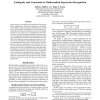Free Online Productivity Tools
i2Speak
i2Symbol
i2OCR
iTex2Img
iWeb2Print
iWeb2Shot
i2Type
iPdf2Split
iPdf2Merge
i2Bopomofo
i2Arabic
i2Style
i2Image
i2PDF
iLatex2Rtf
Sci2ools
AAAI
1998
1998
Ambiguity and Constraint in Mathematical Expression Recognition
The problem of recognizing mathematical expressions differs significantly from the recognition of standard prose. While in prose significant constraints can be put on the interpretation of a character by the characters immediately preceding and following it, few such simple constraints are present in a mathematical expression. In order to make the problem tractable, effective methods of recognizing mathematical expressions will need to put intelligent constraints on the possible interpretations. The authors present preliminary results on a system for the recognition of both handwritten and typeset mathematical expressions. While previous systems perform character recognition out of context, the current system maintains ambiguity of the characters until context can be used to disambiguate the interpretation. In addition, the system limits the number of potentially valid interpretations by decomposing the expressions into a sequence of compatible convex regions. The system uses A-star t...
AAAI 1998 | Intelligent Agents | Mathematical Expressions | Mathematical Expressions Differs | Prose Significant Constraints |
| Added | 01 Nov 2010 |
| Updated | 01 Nov 2010 |
| Type | Conference |
| Year | 1998 |
| Where | AAAI |
| Authors | Erik G. Miller, Paul A. Viola |
Comments (0)

